Dynamics of Health Financing among the BRICS: A Literature Review
Abstract
1. Introduction
2. Database & Methods
3. Literature Review
3.1. Bibliometric Analysis
3.2. Narrative Review
3.2.1. Rising Health Spending among BRICS and the Contributing Factors
- 1.
- Population Aging
- 2.
- Rising Noncommunicable Diseases
- 3.
- Advancement in Medical Treatment
3.2.2. Existing Health Financing System
3.2.3. Public Financing of the Health System
3.2.4. Private Financing of the Health System
3.2.5. PPP as a Potential Solution
- (i)
- Given their nature as commercial and profitmaking entities, insurance companies are concerned with maintaining a consistent financing source from insurance funds, lowering the magnitude of pay-outs to healthcare institutions and physicians, and, as a result, exerting strong control over the type and volume of healthcare services delivered by their contracted providers.
- (ii)
- Local funds and their affiliates want to raise the amounts set aside for payment purposes to insurers (or to the providers, in cases where these funds act as the direct insurers). As a result, in many cases, the funds kept a considerable amount of the money they received and invested it in various financial instruments such as stocks.
- (iii)
- Both the central and provincial health administrations lost a significant amount of bureaucratic turf when resources and responsibility for health finance were moved to insurance companies and funds. Government health authorities have frequently sought (sometimes successfully) to withhold employees’ insurance funds and utilize them to meet the shortfall in the state budget areas wholly distinct and unrelated to healthcare [86].
3.3. Conclusions
3.4. Limitations
Author Contributions
Funding
Institutional Review Board Statement
Informed Consent Statement
Data Availability Statement
Conflicts of Interest
References
- Amimo, F.; Lambert, B.; Magit, A.; Hashizume, M. A review of prospective pathways and impacts of COVID-19 on the accessibility, safety, quality, and affordability of essential medicines and vaccines for universal health coverage in Africa. Glob. Health 2021, 17, 42. [Google Scholar] [CrossRef]
- Aria, M.; Cuccurullo, C. Bibliometrix: An R-tool for comprehensive science mapping analysis. J. Inform. 2017, 11, 959–975. [Google Scholar] [CrossRef]
- Bai, P.; Tang, Y.; Zhang, W.; Zeng, M. Does Economic Policy Uncertainty Matter for Healthcare Expenditure in China? A Spatial Econometric Analysis. Front. Public Health 2021, 9, 673778. [Google Scholar] [CrossRef]
- Bärnreuther, S. Disrupting healthcare? Entrepreneurship as an “innovative” financing mechanism in India’s primary care sector. Soc. Sci. Med. 2023, 319, 115314. [Google Scholar] [CrossRef]
- Broomberg, J. Managing the health care market in developing countries: Prospects and problems. Health Policy Plan. 1994, 9, 237–251. [Google Scholar] [CrossRef]
- Buss, P.M.; de Carvalho, A.I. Health promotion in Brazil. Promot. Educ. 2007, 1, 7–12. [Google Scholar] [CrossRef]
- Buttigieg, S.C.; Grima, S.; Camilleri, C. Commentary: Comparison of historical medical spending patterns among the BRICS and G7. Front. Pharmacol. 2016, 7, 213. [Google Scholar] [CrossRef] [PubMed]
- Chang, L.; Mohsin, M.; Iqbal, W. Assessing the nexus between COVID-19 pandemic–driven economic crisis and economic policy: Lesson learned and challenges. Environ. Sci. Pollut. Res. 2022, 30, 22145–22158. [Google Scholar] [CrossRef]
- Chaturvedi, S.; For INCLEN Study Group; Ramji, S.; Arora, N.K.; Rewal, S.; Dasgupta, R.; Deshmukh, V. Time-constrained mother and expanding market: Emerging model of under-nutrition in India. BMC Public Health 2016, 16, 632. [Google Scholar] [CrossRef]
- Chen, X.; Giles, J.; Yao, Y.; Yip, W.; Meng, Q.; Berkman, L.; Chen, H.; Chen, X.; Feng, J.; Feng, Z.; et al. The path to healthy ageing in China: A Peking University–Lancet Commission. Lancet 2022, 400, 1967–2006. [Google Scholar] [CrossRef]
- Chernichovsky, D. What can developing economies learn from health system reforms of developed economies? Health Policy 1995, 32, 79–91. [Google Scholar] [CrossRef]
- Daemmrich, A. The political economy of healthcare reform in China: Negotiating public and private. Springerplus 2013, 2, 448. [Google Scholar] [CrossRef]
- Deussom, R.; Lal, A.; Frymus, D.; Cole, K.; Politico, M.R.S.; Saldaña, K.; Vasireddy, V.; Khangamwa, G.; Jaskiewicz, W. Putting health workers at the centre of health system investments in COVID-19 and beyond. Fam. Med. Community Health 2022, 10, e001449. [Google Scholar] [CrossRef]
- Devarakonda, S. Hub and spoke model: Making rural healthcare in India affordable, available and accessible. Rural Remote Health 2016, 16, 3476. [Google Scholar] [CrossRef]
- Dilip, T.R. Utilization of inpatient care from private hospitals: Trends emerging from Kerala, India. Health Policy Plan. 2010, 25, 437–446. [Google Scholar] [CrossRef] [PubMed]
- Ecevit, E.; Cetin, M.; Kocak, E.; Dogan, R.; Yildiz, O. Greenhouse gas emissions, economic globalization, and health expenditures nexus: Does population aging matter in emerging market economies? Environ. Sci. Pollut. Res. 2022, 30, 29961–29975. [Google Scholar] [CrossRef]
- Ezziane, Z. Essential drugs production in Brazil, Russia, India, China and South Africa (BRICS): Opportunities and challenges. Int. J. Health Policy Manag. 2014, 3, 365–370. [Google Scholar] [CrossRef]
- Floyd, K.; Fitzpatrick, C.; Pantoja, A.; Raviglione, M. Domestic and donor financing for tuberculosis care and control in low-income and middle-income countries: An analysis of trends, 2002–2011, and requirements to meet 2015 targets. Lancet Glob. Health 2013, 1, e105. [Google Scholar] [CrossRef] [PubMed][Green Version]
- Ganju, A.; Goulart, A.C.; Ray, A.; Majumdar, A.; Jeffers, B.W.; Llamosa, G.; Cañizares, H.; Ramos-Cañizares, I.J.; Fadhil, I.; Subramaniam, K.; et al. Systemic Solutions for Addressing Non-Communicable Diseases in Low- and Middle-Income Countries. JMDH 2020, 13, 693–707. [Google Scholar] [CrossRef] [PubMed]
- Garber, A.M.; Romer, P.M. Evaluating the federal role in financing health-related research. Proc. Natl. Acad. Sci. USA 1996, 93, 12717–12724. [Google Scholar] [CrossRef]
- Zammar, G.; Meister, H.; Shah, J.; Phadtare, A.; Cofiel, L.; Pietrobon, R. So Different, yet So Similar: Meta-Analysis and Policy Modeling of Willingness to Participate in Clinical Trials among Brazilians and Indians. PLoS ONE 2010, 5, e14368. [Google Scholar] [CrossRef] [PubMed]
- Glassman, A.; Giedion, U.; McQueston, K. Priority setting for health in emerging markets. J. Comp. Eff. Res. 2013, 2, 283–291. [Google Scholar] [CrossRef] [PubMed]
- Gomes, W.J. EACTS in the future: Second strategic conference. The view from the BRICS countries. Eur. J. Cardio-Thorac. Surg. 2012, 43, 238–240. [Google Scholar] [CrossRef]
- Grogan, C.M. Urban economic reform and access to health care coverage in the People’s Republic of China. Soc. Sci. Med. 1995, 41, 1073–1084. [Google Scholar] [CrossRef]
- Gu, L.; Wang, M.C.; Li, F. The correlation between economic fluctuation, workforce employment and health expenditure in the BRICS countries. Front. Public Health 2022, 10, 933728. [Google Scholar] [CrossRef]
- Harmer, A. The BRICS countries: A new force in global health? Bull. World Health Organ. 2014, 92, 394–395. [Google Scholar] [CrossRef]
- Head, S.J.; Howell, N.J.; Osnabrugge, R.L.; Ben Bridgewater, B.; Keogh, B.E.; Kinsman, R.; Walton, P.; Gummert, J.F.; Pagano, D.; Kappetein, A.P. The European Association for Cardio-Thoracic Surgery (EACTS) database: An introduction. Eur. J. Cardio-Thorac. Surg. 2013, 44, e175–e180. [Google Scholar] [CrossRef]
- Iemmi, V. Global collective action in mental health financing: Allocation of development assistance for mental health in 142 countries, 2000–2015. Soc. Sci. Med. 2021, 287, 114354. [Google Scholar] [CrossRef]
- Jaikumar, S.; Dutta, S.; Sood, N. Impact of lifestyle diseases on income and household consumption: Evidence from an emerging economy. Health Mark. Q. 2021, 38, 35–49. [Google Scholar] [CrossRef]
- Jakovljevic, M.; Groot, W.; Souliotis, K. Editorial: Health care financing and affordability in the emerging global markets, Volume II. Front. Public Health 2022, 10, 1054409. [Google Scholar] [CrossRef]
- Local Burden of Disease HIV Collaborators. Mapping subnational HIV mortality in six Latin American countries with incomplete vital registration systems. BMC Med. 2021, 19, 4. [Google Scholar] [CrossRef]
- Jakovljevic, M.B.; Getzen, T.E.; Torbica, A.; Anegawa, T. 10th World IHEA and ECHE joint congress: Health Economics in the Age of Longevity. Expert Rev. Pharmacoecon. Outcomes Res. 2014, 14, 781–783. [Google Scholar] [CrossRef] [PubMed]
- Jakovljevic, M.; Jakab, M.; Gerdtham, U.; McDaid, D.; Ogura, S.; Varavikova, E.; Merrick, J.; Adany, R.; Okunade, A.; Getzen, T.E. Comparative financing analysis and political economy of noncommunicable diseases. J. Med. Econ. 2019, 22, 722–727. [Google Scholar] [CrossRef]
- Jakovljevic, M.; Lamnisos, D.; Westerman, R.; Chattu, V.K.; Cerda, A. Future health spending forecast in leading emerging BRICS markets in 2030: Health policy implications. Health Res. Policy Syst. 2022, 20, 23. [Google Scholar] [CrossRef]
- Wong, Y.C.; Leung, J. Long-term Care in China: Issues and Prospects. J. Gerontol. Soc. Work. 2012, 55, 570–586. [Google Scholar] [CrossRef] [PubMed]
- Jakovljevic, M.; Liu, Y.; Cerda, A.; Simonyan, M.; Correia, T.; Mariita, R.M.; Kumara, A.S.; Garcia, L.; Krstic, K.; Osabohien, R.; et al. The Global South political economy of health financing and spending landscape—History and presence. J. Med. Econ. 2021, 24, 25–33. [Google Scholar] [CrossRef] [PubMed]
- Jakovljevic, M.; Matter-Walstra, K.; Sugahara, T.; Sharma, T.; Reshetnikov, V.; Merrick, J.; Yamada, T.; Youngkong, S.; Rovira, J. Cost-effectiveness and resource allocation (CERA) 18 years of evolution: Maturity of adulthood and promise beyond tomorrow. Cost Eff. Resour. Alloc. 2020, 18, 15. [Google Scholar] [CrossRef]
- Wang, W.; Hafeez, M.; Jiang, H.; Ashraf, M.U.; Asif, M.; Akram, M.W. How do energy prices and climate shocks affect human health? Insights from BRICS. Environ. Sci. Pollut. Res. 2022, 30, 32751–32761. [Google Scholar] [CrossRef]
- Jakovljevic, M.; Ogura, S. Editorial: Insights in health economics: 2021. Front. Public Health 2022, 10, 966741. [Google Scholar] [CrossRef]
- Jakovljevic, M.; Péntek, M.; Wijeratne, T.; Kockaya, G.; Pau, L.F. Editorial: Accelerated Globalization and Its Impact to the World’s Health Care Achievement. Front. Public Health 2021, 9, 690239. [Google Scholar] [CrossRef]
- Jakovljevic, M.; Potapchik, E.; Popovich, L.; Barik, D.; Getzen, T.E. Evolving Health Expenditure Landscape of the BRICS Nations and Projections to 2025: BRICS Health Spending. Health Econ. 2016, 26, 844–852. [Google Scholar] [CrossRef] [PubMed]
- Jakovljevic, M.; Sharma, T.; Kumagai, N.; Ogura, S. Editorial: NCDs—Core Challenge of Modern Day Health Care Establishments. Front. Public Health 2021, 9, 692926. [Google Scholar] [CrossRef]
- Jakovljevic, M.; Timofeyev, Y.; Ekkert, N.V.; Fedorova, J.V.; Skvirskaya, G.; Bolevich, S.; Reshetnikov, V.A. The impact of health expenditures on public health in BRICS nations. J. Sport Health Sci. 2019, 8, 516–519. [Google Scholar] [CrossRef]
- Jakovljevic, M.; Timofeyev, Y.; Ranabhat, C.L.; Fernandes, P.O.; Teixeira, J.P.; Rancic, N.; Reshetnikov, V. Real GDP growth rates and healthcare spending—Comparison between the G7 and the EM7 countries. Glob. Health 2020, 16, 64. [Google Scholar] [CrossRef]
- Jakovljevic, M.B.; Milovanovic, O. Growing Burden of Non-Communicable Diseases in the Emerging Health Markets: The Case of BRICS. Front. Public Health 2015, 3, 65. [Google Scholar] [CrossRef]
- Jakovljevic, M.B. BRIC’s Growing Share of Global Health Spending and Their Diverging Pathways. Front. Public Health 2015, 3, 135. [Google Scholar] [CrossRef]
- Jakovljevic, M.M. Comparison of historical medical spending patterns among the BRICS and G7. J. Med. Econ. 2015, 19, 70–76. [Google Scholar] [CrossRef]
- Jiang, C.; Chang, H.; Shahzad, I. Digital Economy and Health: Does Green Technology Matter in BRICS Economies? Front. Public Health 2022, 9, 827915. [Google Scholar] [CrossRef]
- Katyal, A.; Singh, P.V.; Bergkvist, S.; Samarth, A.; Rao, M. Private sector participation in delivering tertiary health care: A dichotomy of access and affordability across two Indian states. Health Policy Plan 2015, 30, i23–i31. [Google Scholar] [CrossRef]
- Kocarnik, J.M.; Compton, K.; Dean, F.E.; Fu, W.; Gaw, B.L.; Harvey, J.D.; Henrikson, H.J.; Lu, D.; Pennini, A.; Xu, R.; et al. Cancer Incidence, Mortality, Years of Life Lost, Years Lived With Disability, and Disability-Adjusted Life Years for 29 Cancer Groups From 2010 to 2019: A Systematic Analysis for the Global Burden of Disease Study 2019. JAMA Oncol. 2022, 8, 420. [Google Scholar] [CrossRef]
- Mao, W.; Jiang, H.; Mossialos, E.; Chen, W. Improving access to medicines: Lessons from 10 years of drug reforms in China, 2009–2020. BMJ Glob. Health 2022, 7, e009916. [Google Scholar] [CrossRef]
- Kumar, A.; Juluru, K.; Thimmaraju, P.K.; Reddy, J.; Patil, A. Pharmaceutical market access in emerging markets: Concepts, components, and future. J. Mark. Access Health Policy 2014, 2, 25302. [Google Scholar] [CrossRef] [PubMed]
- Lawrence, M.; Rayner, M. Functional foods and health claims: A public health policy perspective. Public Health Nutr. 1998, 1, 75–82. [Google Scholar] [CrossRef] [PubMed][Green Version]
- Li, F.; Chang, T.; Wang, M.C.; Zhou, J. The relationship between health expenditure, CO2 emissions, and economic growth in the BRICS countries—Based on the Fourier ARDL model. Environ. Sci. Pollut. Res. 2022, 29, 10908–10927. [Google Scholar] [CrossRef]
- Littlejohns, P. The BRICS development bank and health. Lancet 2013, 382, 126. [Google Scholar] [CrossRef] [PubMed]
- Liu, J.; Miao, J.; Zhang, D. Dilemma of healthcare reform and invention of new discipline of health fiscalogy. Glob. Health Res. Policy 2016, 1, 4. [Google Scholar] [CrossRef][Green Version]
- Mv, M.K.; Sastry, N.K.B.; Moonesar, I.A.; Rao, A. Predicting Universal Healthcare Through Health Financial Management for Sustainable Development in BRICS, GCC, and AUKUS Economic Blocks. Front. Artif. Intell. 2022, 5, 887225. [Google Scholar] [CrossRef]
- McLeod, H.; Grobler, P. The role of risk equalization in moving from voluntary private health insurance to mandatory coverage: The experience in South Africa. In Advances in Health Economics and Health Services Research; Chernichovsky, D., Hanson, K., Eds.; Emerald Group Publishing Limited: Bingley, UK, 2009; pp. 159–196. Available online: https://www.emerald.com/insight/content/doi/10.1108/S0731-2199(2009)0000021010/full/html (accessed on 31 March 2023).
- McPAKE, B.; Banda, E.E.N. Contracting out of health services in developing countries. Health Policy Plan. 1994, 9, 25–30. [Google Scholar] [CrossRef]
- Mielke, G.I.; Brown, W.J. Physical activity and the prevention of chronic illness in the BRICS nations: Issues relating to gender equality. J. Sport Health Sci. 2019, 8, 507–508. [Google Scholar] [CrossRef]
- Munodawafa, D.; Onya, H.; Amuyunzu-Nyamongo, M.; Mweemba, O.; Phori, P.; Kobie, A.G. Achieving SDGs and addressing health emergencies in Africa: Strengthening health promotion. Glob. Health Promot. 2021, 28, 97–103. [Google Scholar] [CrossRef]
- Oortwijn, W.; Mathijssen, J.; Banta, D. The role of health technology assessment on pharmaceutical reimbursement in selected middle-income countries. Health Policy 2010, 95, 174–184. [Google Scholar] [CrossRef]
- Pagliusi, S.; Che, Y.; Dong, S. The art of partnerships for vaccines. Vaccine 2019, 37, 5909–5919. [Google Scholar] [CrossRef] [PubMed]
- Paul, E.; Brown, G.W.; Ridde, V. Misunderstandings and ambiguities in strategic purchasing in low- and middle-income countries. Int. J. Health Plan. Manag. 2020, 35, 1001–1008. [Google Scholar] [CrossRef]
- Peer, N. Current strategies are inadequate to curb the rise of tobacco use in Africa. S. Afr. Med. J. 2018, 108, 551–556. [Google Scholar] [CrossRef] [PubMed]
- Dal Poz, M.R.; Couto, M.H.C.; de Andrade Vidaurre Franco, T. Innovation, development, and financing of institutions of Higher Education in health. Cad. Saúde Pública 2016, 32, e00139915. [Google Scholar] [CrossRef][Green Version]
- Prasolov, A.V.; Kolbin, A.S.; Balykina, Y.E. Optimization Approach for Estimating the Required Amount of Pharmaceuticals in the Russian Federation. Value Health Reg. Issues 2018, 16, 39–45. [Google Scholar] [CrossRef]
- Purohit, B.C. Private initiatives and policy options: Recent health system experience in India. Health Policy Plan 2001, 16, 87–97. [Google Scholar] [CrossRef] [PubMed]
- RamPrakash, R.; Lingam, L. Why is women’s utilization of a publicly funded health insurance low?: A qualitative study in Tamil Nadu, India. BMC Public Health 2021, 21, 350. [Google Scholar] [CrossRef] [PubMed]
- Rao, K.D.; Petrosyan, V.; Araujo, E.C.; McIntyre, D. Progress towards universal health coverage in BRICS: Translating economic growth into better health. Bull. World Health Organ. 2014, 92, 429–435. [Google Scholar] [CrossRef]
- Rezaie, R.; McGahan, A.M.; Frew, S.E.; Daar, A.S.; Singer, P.A. Emergence of biopharmaceutical innovators in China, India, Brazil, and South Africa as global competitors and collaborators. Health Res. Policy Syst. 2012, 10, 18. [Google Scholar] [CrossRef]
- Rizvi, S.S.; Douglas, R.; Williams, O.D.; Hill, P.S. The political economy of universal health coverage: A systematic narrative review. Health Policy Plan 2020, 35, 364–372. [Google Scholar] [CrossRef]
- Romaniuk, P.; Poznańska, A.; Brukało, K.; Holecki, T. Health System Outcomes in BRICS Countries and Their Association With the Economic Context. Front. Public Health 2020, 8, 80. [Google Scholar] [CrossRef] [PubMed]
- Yip, W.; Hsiao, W. Harnessing the privatisation of China’s fragmented health-care delivery. Lancet 2014, 384, 805–818. [Google Scholar] [CrossRef]
- Sariyer, G.; Kahraman, S.; Sözen, M.E.; Ataman, M.G. Fiscal responses to COVID-19 outbreak for healthy economies: Modelling with big data analytics. Struct. Chang. Econ. Dyn. 2023, 64, 191–198. [Google Scholar] [CrossRef]
- Savitha, B.; Banerjee, S. Education and Experience as Determinants of Micro Health Insurance Enrolment. Int. J. Health Policy Manag. 2020, 10, 192–200. [Google Scholar] [CrossRef] [PubMed]
- Siow, Y.L.; Gong, Y.; Au-Yeung, K.K.; Woo, C.W.; Choy, P.C.; O, K. Emerging issues in traditional Chinese medicine. Can. J. Physiol. Pharmacol. 2005, 83, 321–334. [Google Scholar] [CrossRef]
- So, A.D.; Ruiz-Esparza, Q. Technology innovation for infectious diseases in the developing world. Infect. Dis. Poverty 2012, 1, 2. [Google Scholar] [CrossRef] [PubMed]
- Song, Z.; Zhu, Y.; Zou, H.; Fu, H.; Yip, W. A Tale of Transition: Trends of Catastrophic Health Expenditure and Impoverishment in Urban China, 1986–2009. Health Syst. Reform 2020, 6, e1836731. [Google Scholar] [CrossRef]
- Sparkes, S.P.; Kutzin, J.; Earle, A.J. Financing Common Goods for Health: A Country Agenda. Health Syst. Reform 2019, 5, 322–333. [Google Scholar] [CrossRef]
- Stubbs, T.; Kring, W.; Laskaridis, C.; Kentikelenis, A.; Gallagher, K. Whatever it takes? The global financial safety net, COVID-19, and developing countries. World Dev. 2020, 137, 105171. [Google Scholar] [CrossRef]
- Marshall, K.; Beaden, P.; Durrani, H.; Tang, K.; Mogilevskii, R.; Bhutta, Z. The role of the private sector in noncommunicable disease prevention and management in low- and middle-income countries: A series of systematic reviews and thematic syntheses. Int. J. Qual. Stud. Health Well-Being 2023, 18, 2156099. [Google Scholar] [CrossRef] [PubMed]
- Sun, J. International experiences of promoting generics use and its implications to China: Promoting generics use. JEBM 2013, 6, 74–80. [Google Scholar] [CrossRef]
- The Lancet. Banking on the BRICS for health? Lancet 2013, 381, 1158. [Google Scholar] [CrossRef]
- Twigg, J.L. Health care reform in Russia: A survey of head doctors and insurance administrators. Soc. Sci. Med. 2002, 55, 2253–2265. [Google Scholar] [CrossRef]
- Twigg, J.L. Obligatory medical insurance in Russia: The participants’ perspective. Soc. Sci. Med. 1999, 49, 371–382. [Google Scholar] [CrossRef] [PubMed]
- Usman, M.; Ma, Z.; Wasif Zafar, M.; Haseeb, A.; Ashraf, R.U. Are Air Pollution, Economic and Non-Economic Factors Associated with Per Capita Health Expenditures? Evidence from Emerging Economies. Int. J. Environ. Res. Public Health 2019, 16, 1967. [Google Scholar] [CrossRef] [PubMed]
- Bustamante, A.V.; Shimoga, S.V. Comparing the Income Elasticity of Health Spending in Middle-Income and High-Income Countries: The Role of Financial Protection. Int. J. Health Policy Manag. 2017, 7, 255–263. [Google Scholar] [CrossRef]
- Vargas, V.; Ahmed, S.; Adams, A.M. Factors enabling comprehensive maternal health services in the benefits package of emerging financing schemes: A cross-sectional analysis from 1990 to 2014. PLoS ONE 2018, 13, e0201398. [Google Scholar] [CrossRef] [PubMed]
- Vineis, P. Life Trajectories, Biomedical Evidence, and Lessons for Policies. Front. Public Health 2020, 8, 160. [Google Scholar] [CrossRef]
- Ullah, Z.; Sulaiman, M.A.B.A.; Ali, S.B.; Ahmad, N.; Scholz, M.; Han, H. The Effect of Work Safety on Organizational Social Sustainability Improvement in the Healthcare Sector: The Case of a Public Sector Hospital in Pakistan. Int. J. Environ. Res. Public Health 2021, 18, 6672. [Google Scholar] [CrossRef]
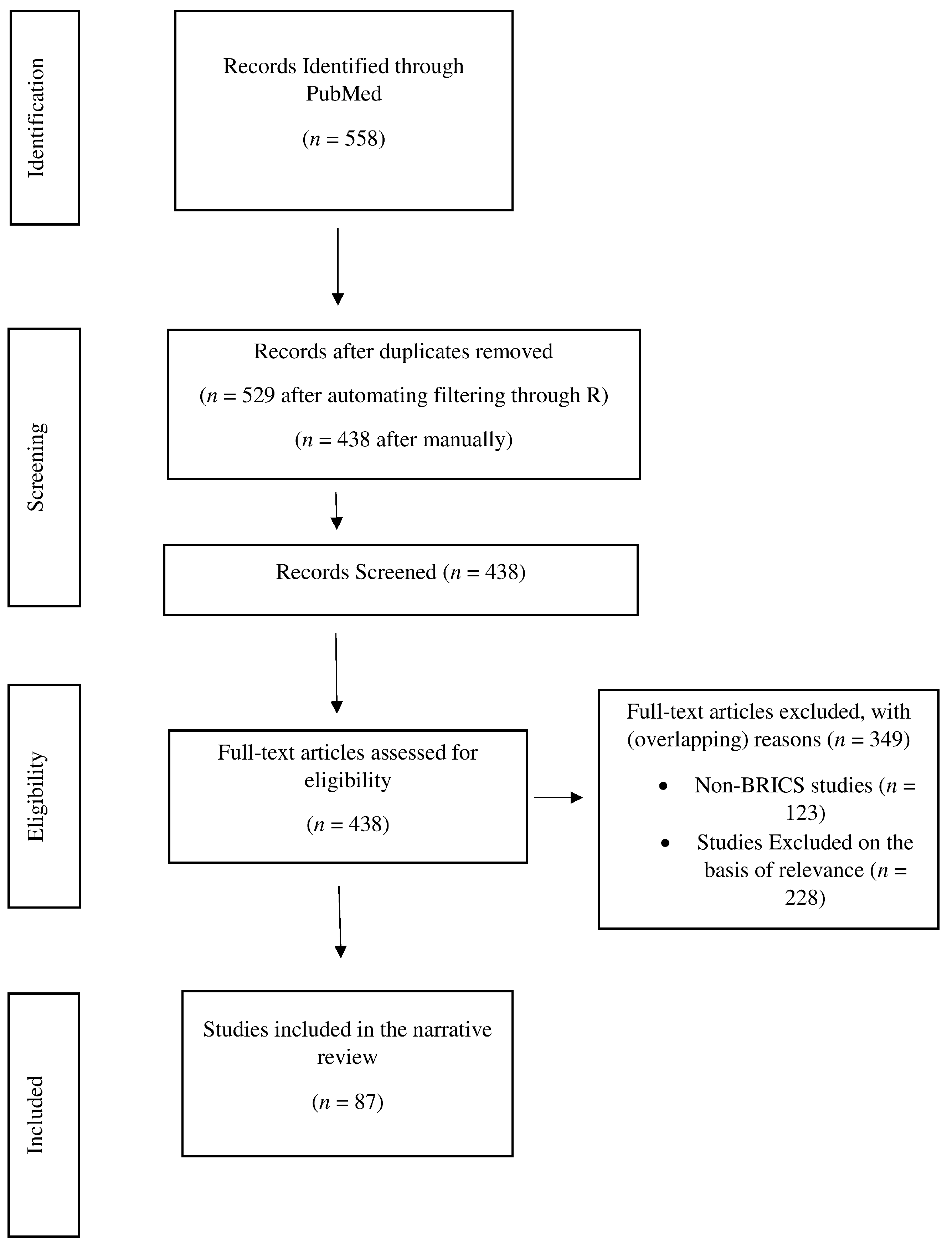
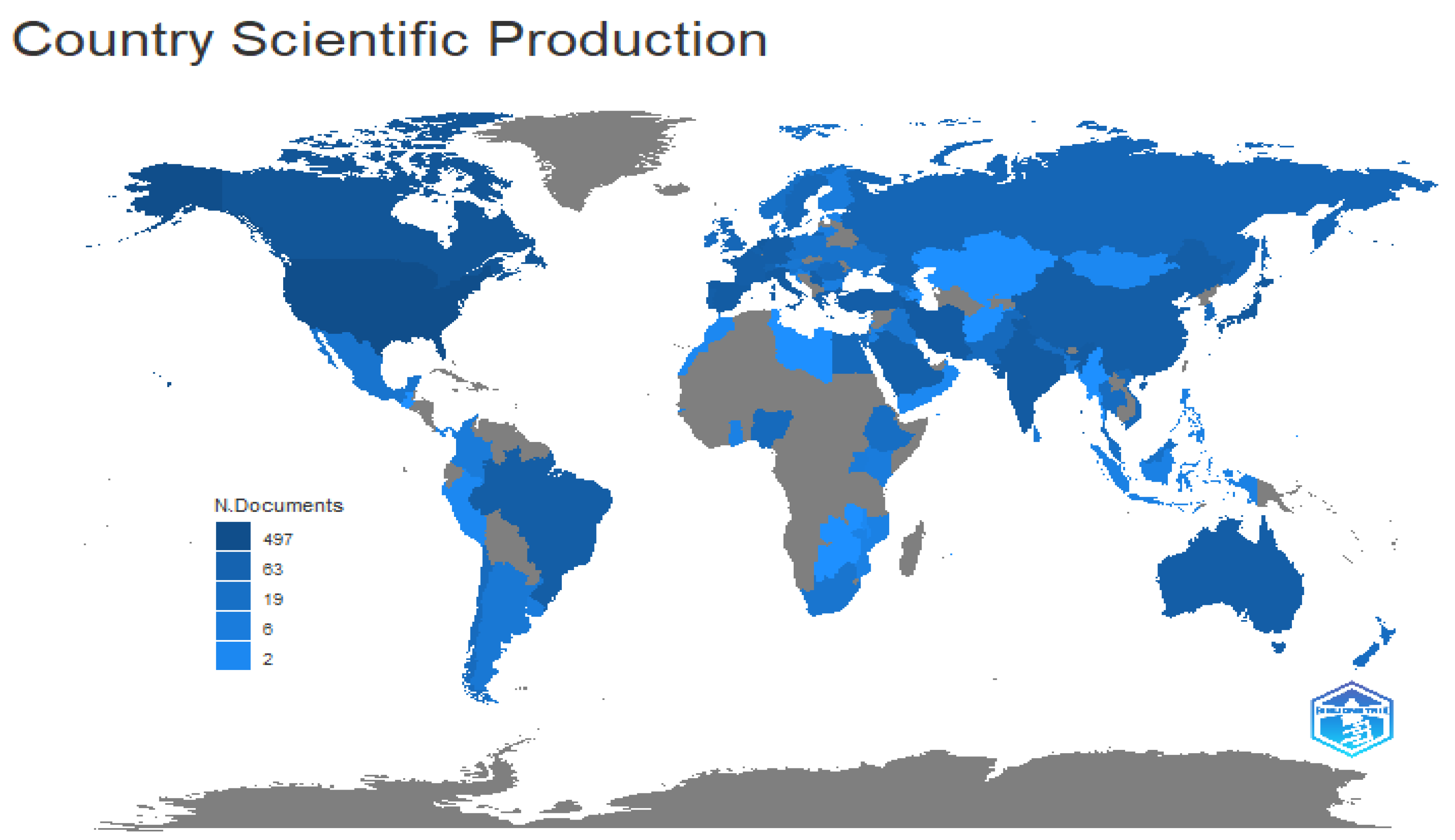
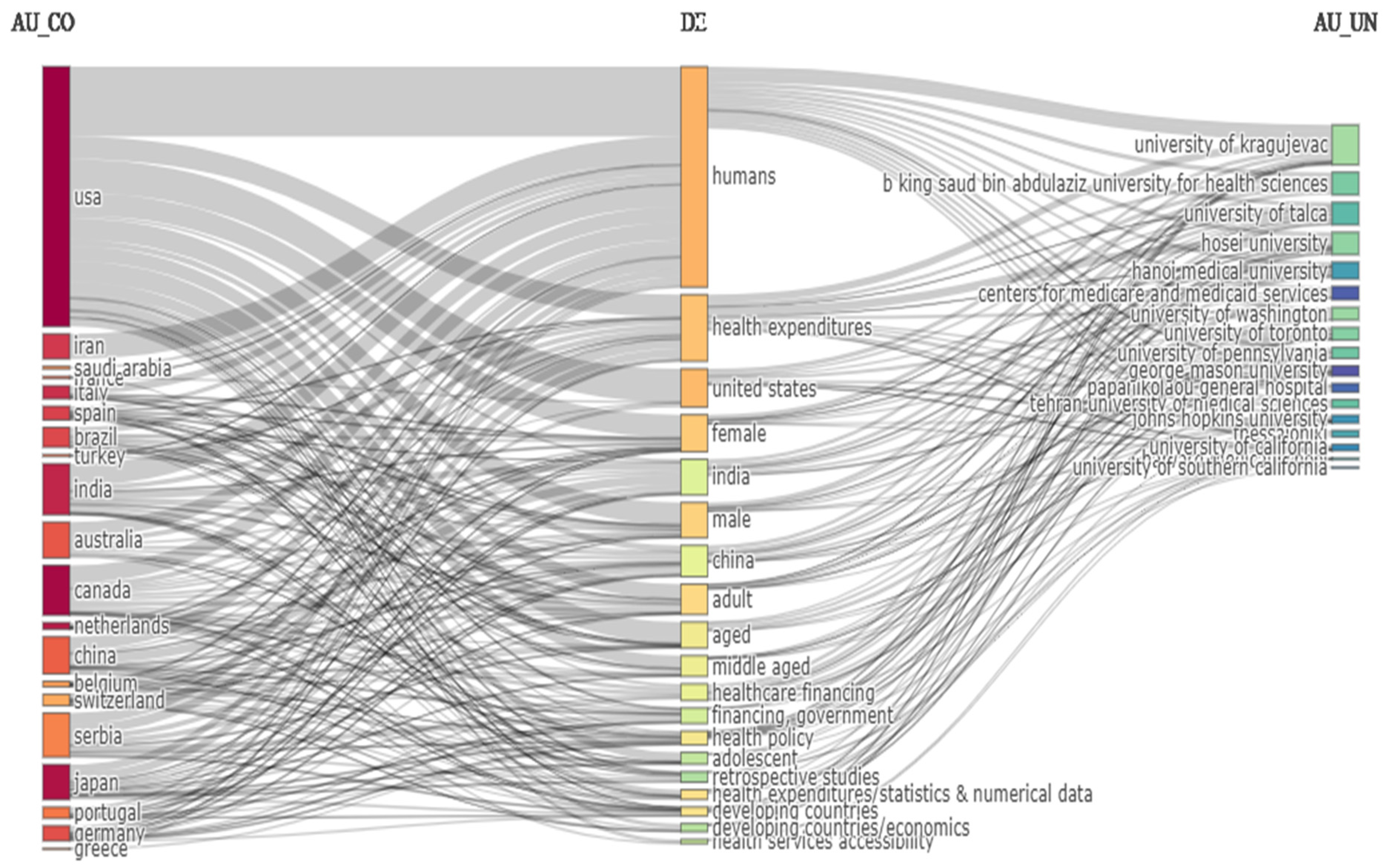
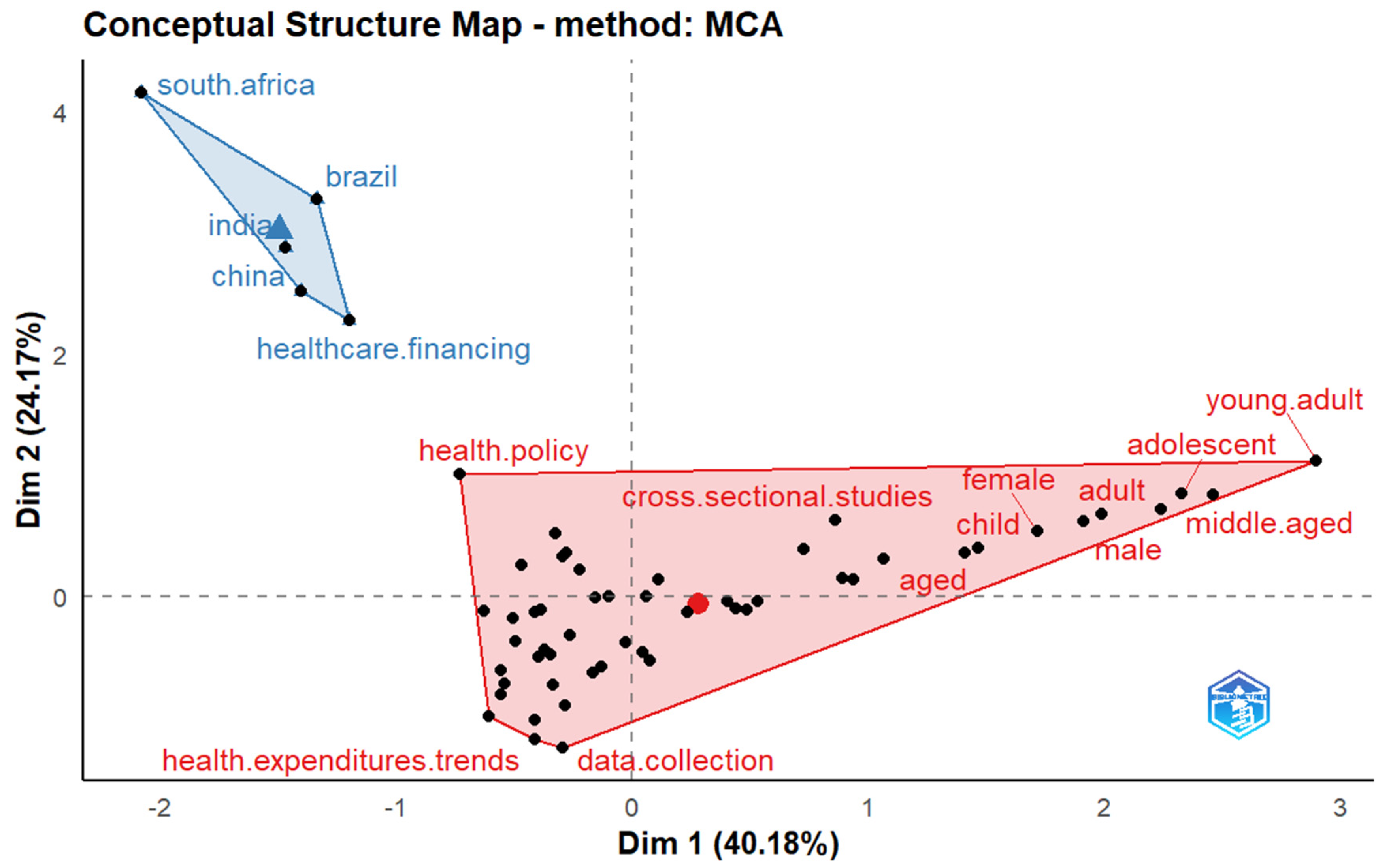
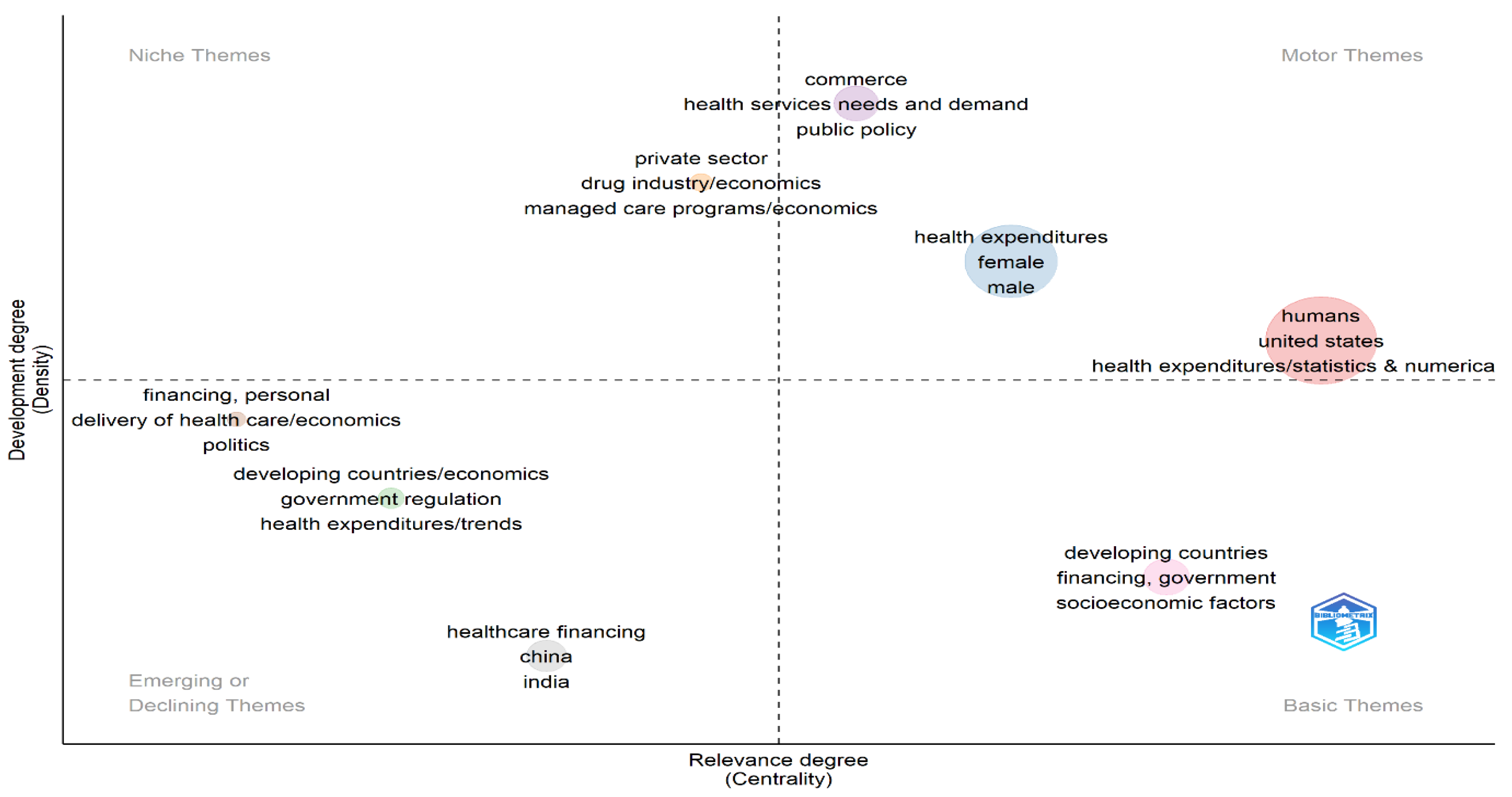
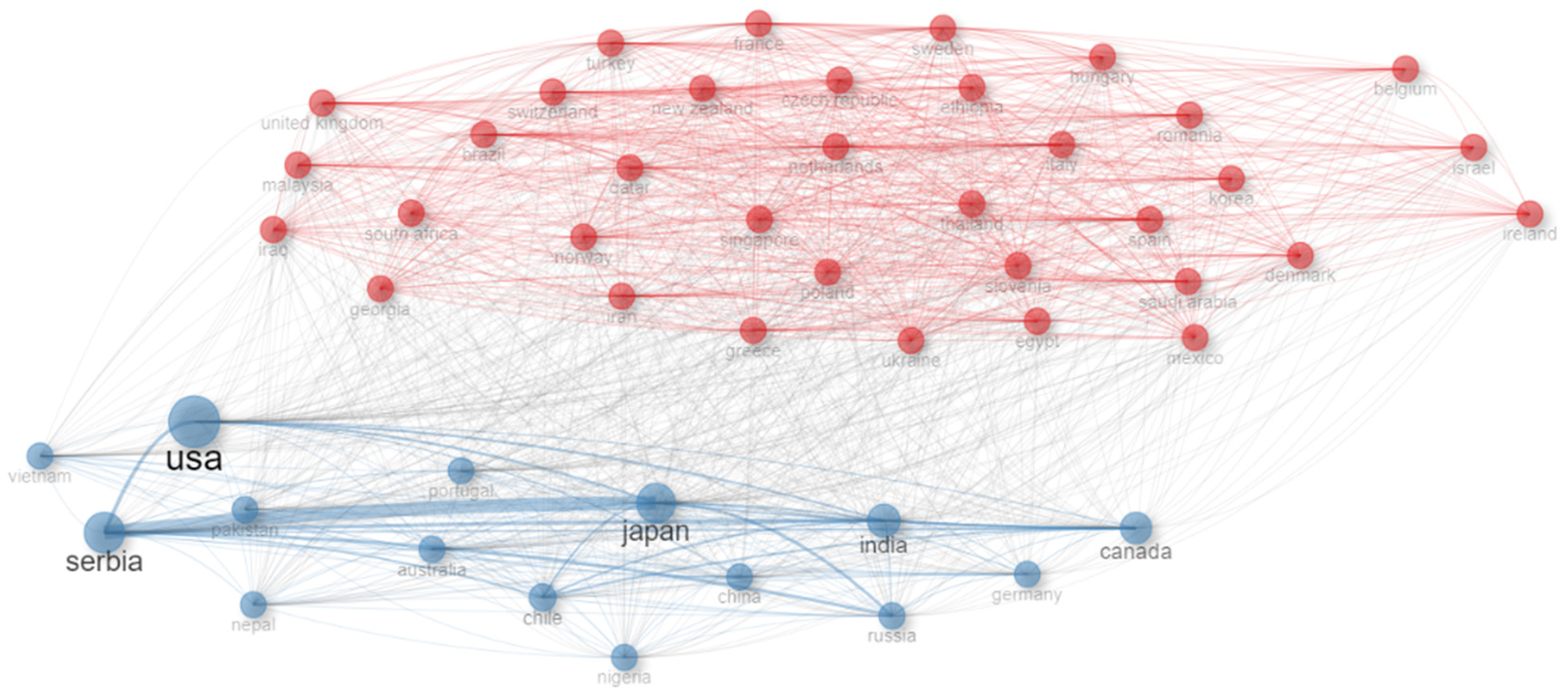
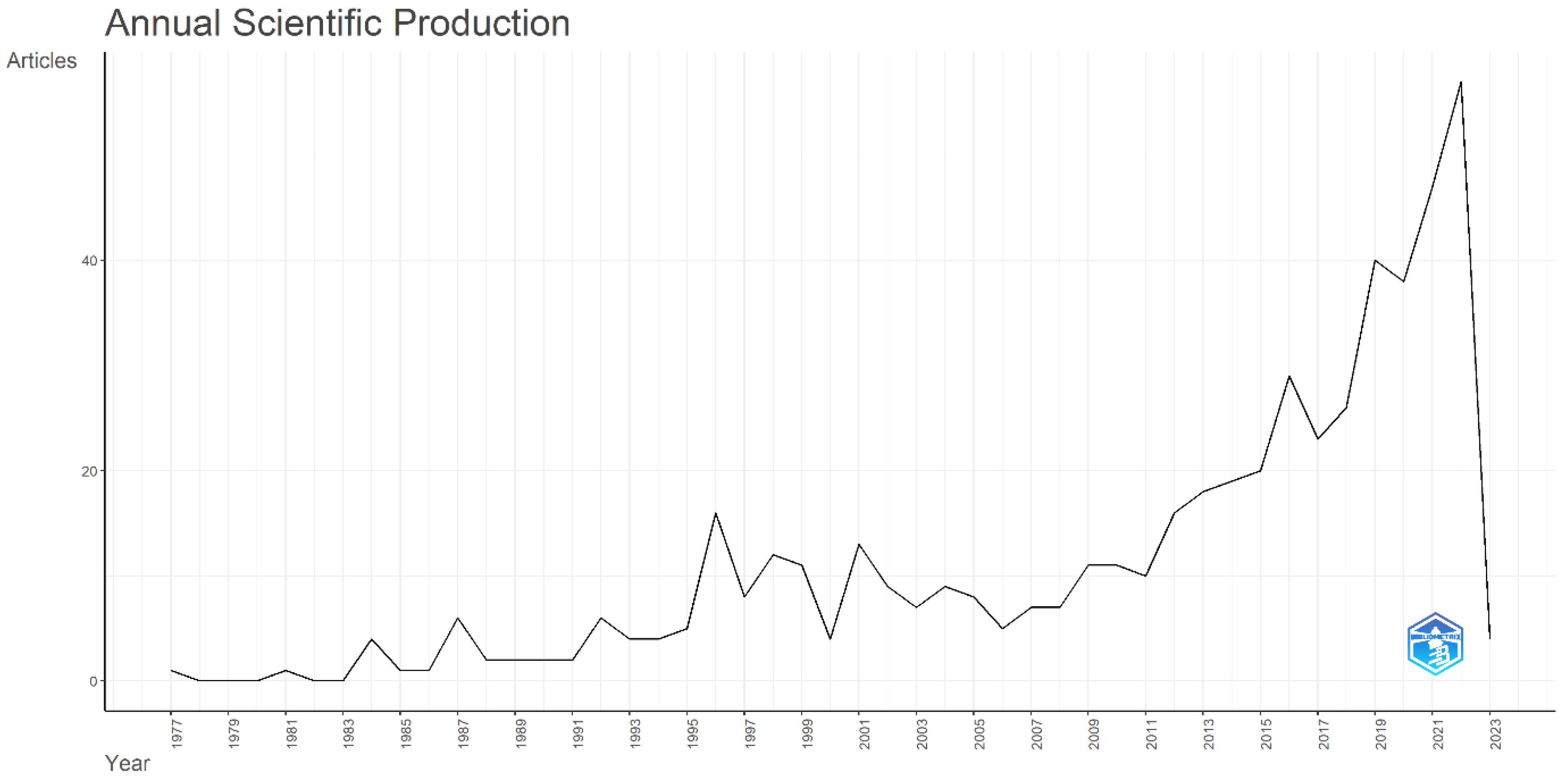
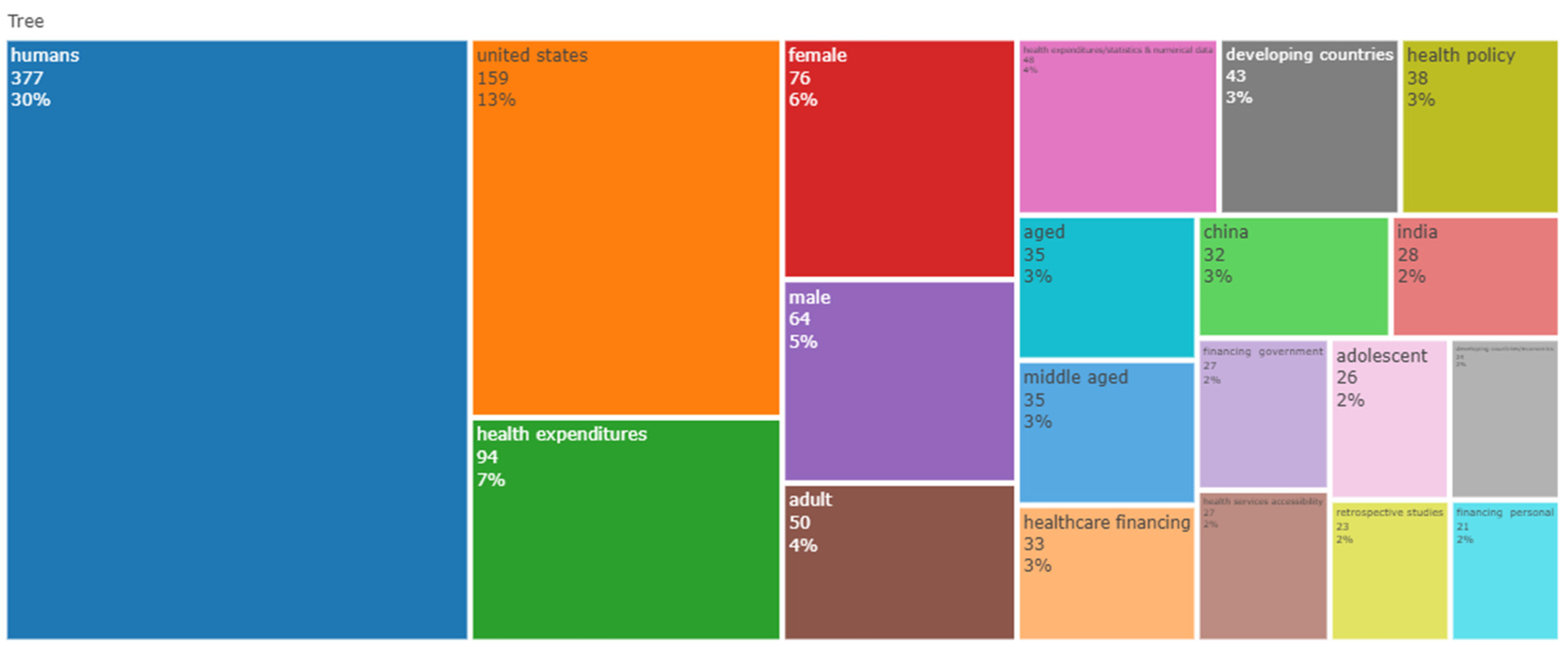
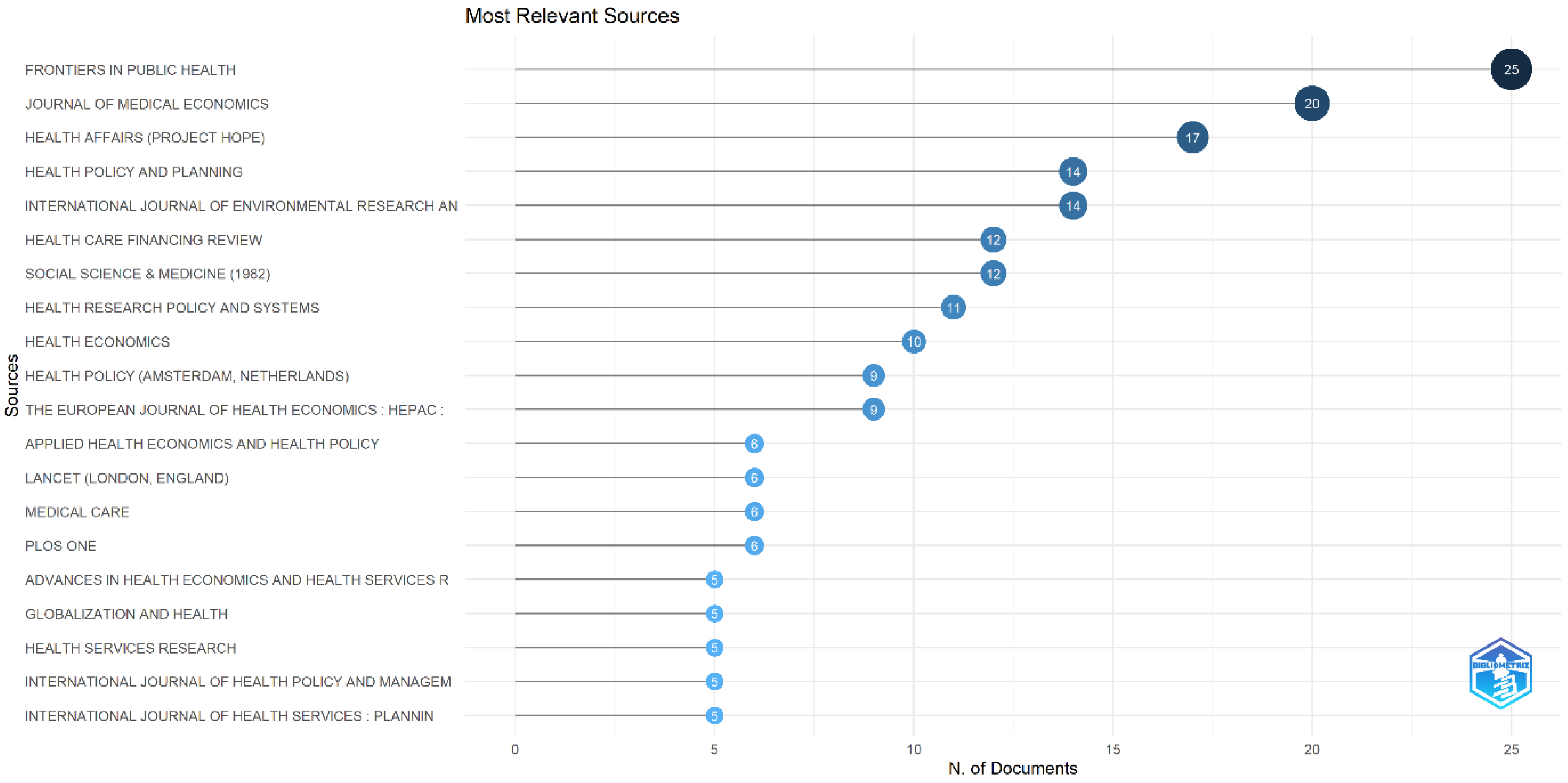
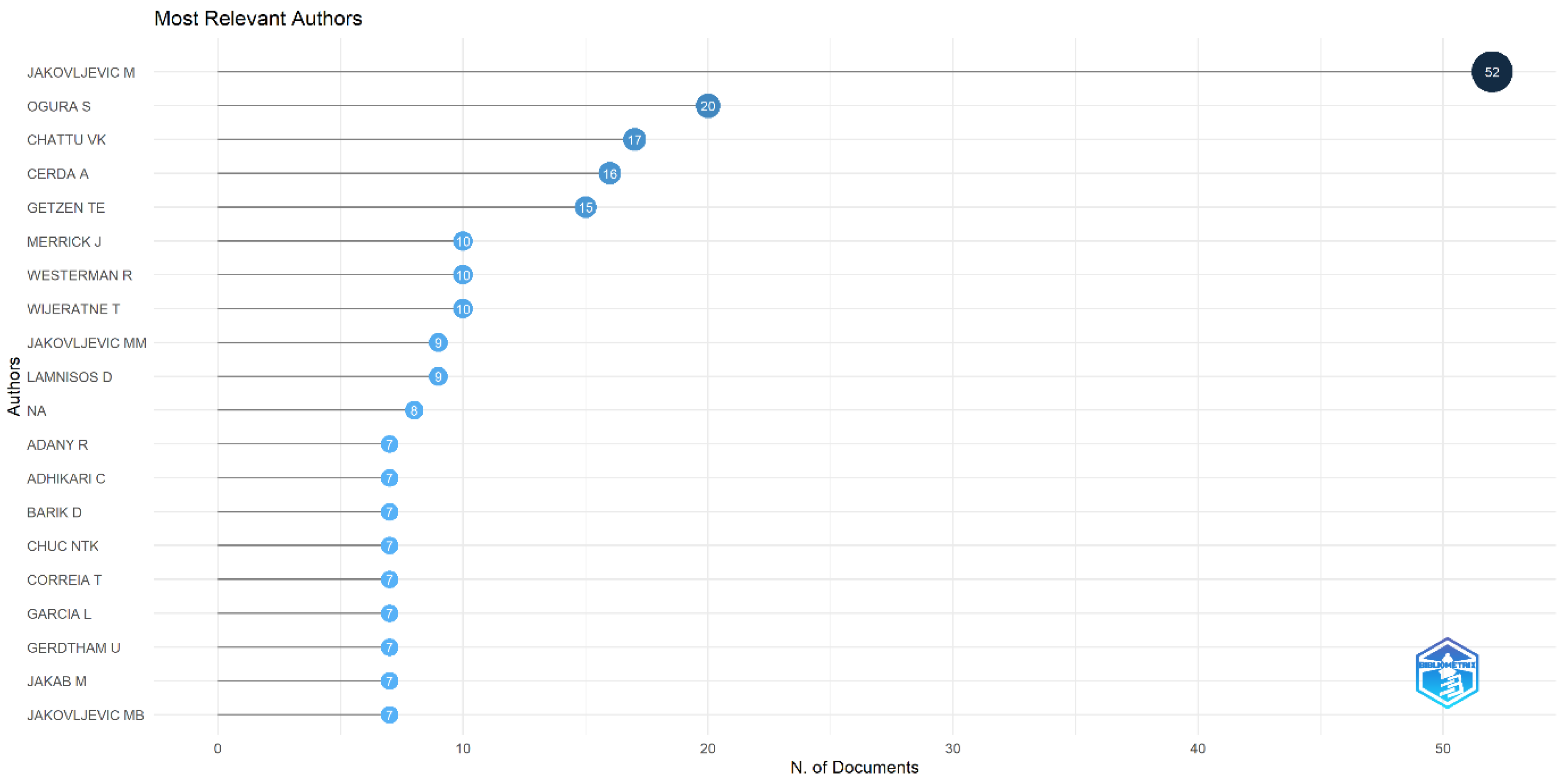
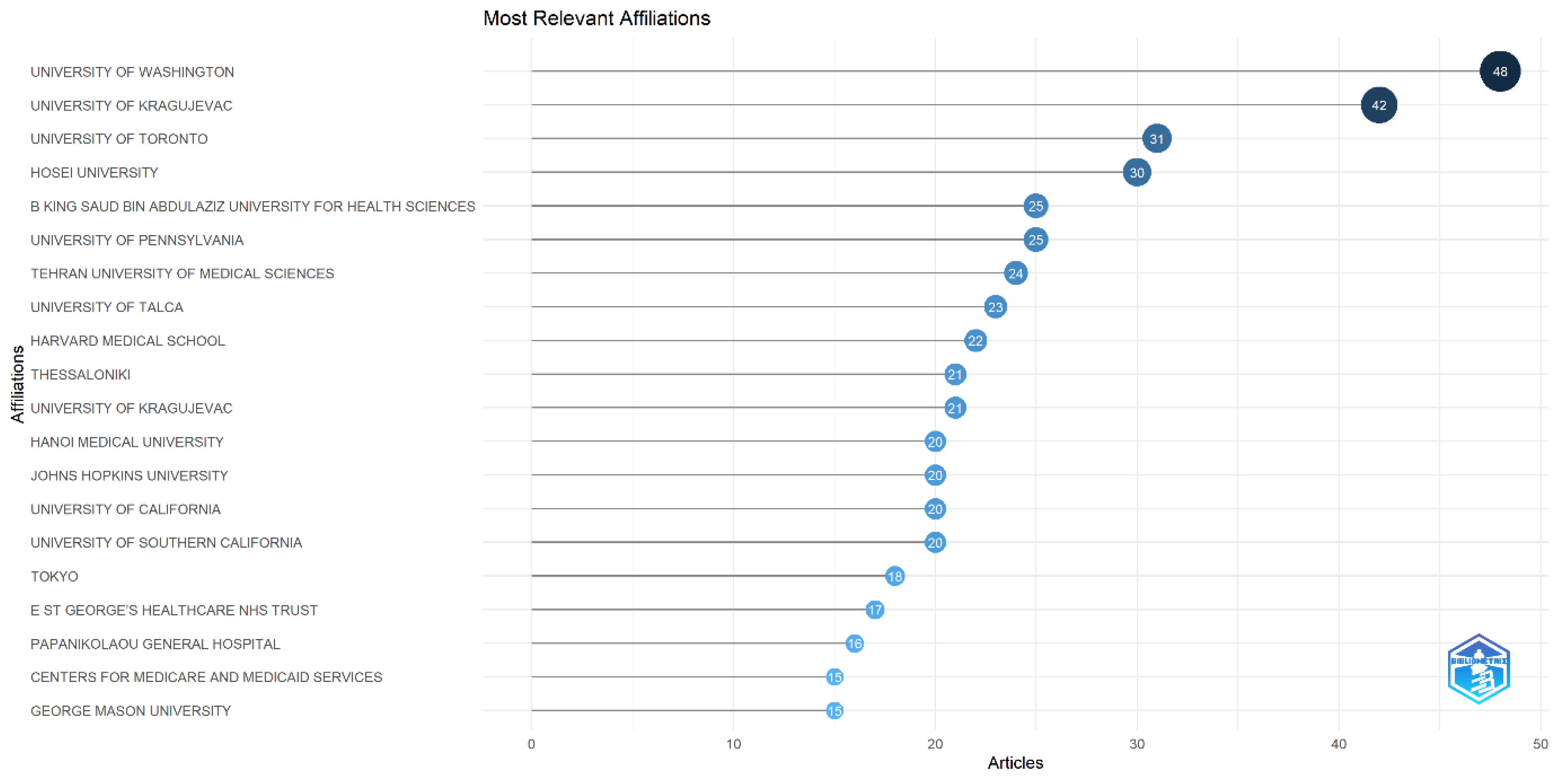
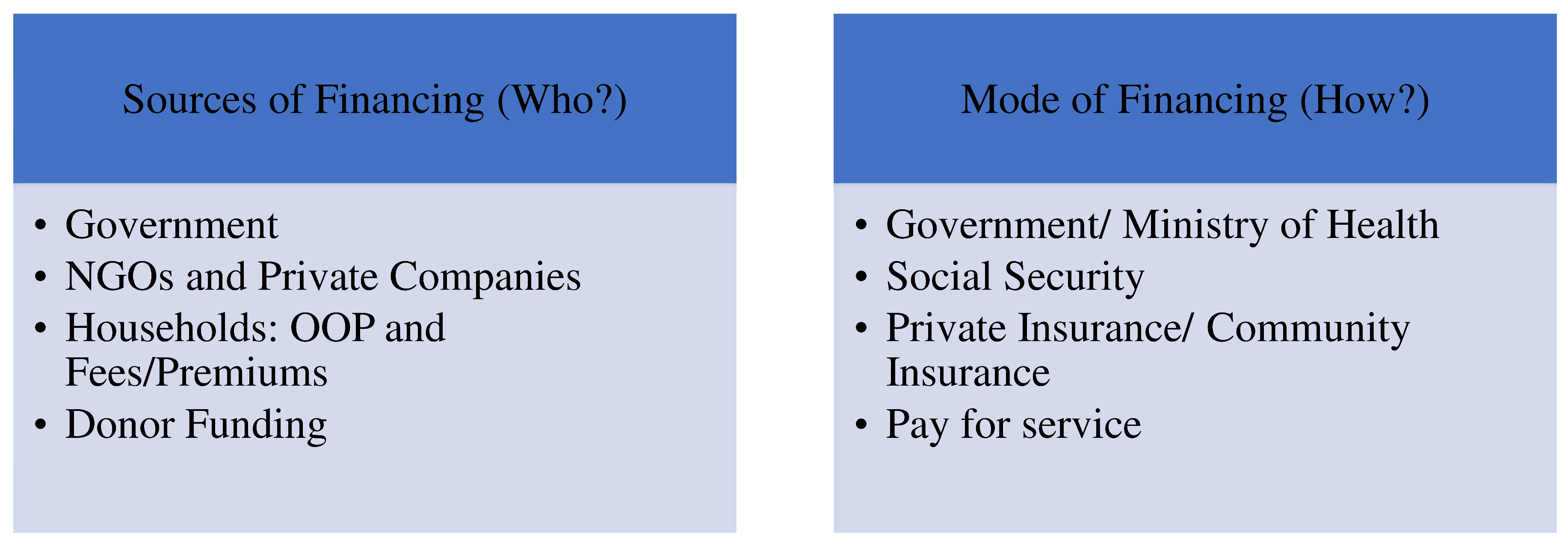
| Sl. No. | Keywords Searched | Records Identified | Period Covered |
|---|---|---|---|
| 1 | Health Expenditure AND Emerging Markets | 183 | 1977–2023 |
| 2 | Health Spending AND Emerging Markets | 121 | 1984–2023 |
| 3 | Health Financing AND Emerging Markets | 178 | 1981–2023 |
| 4 | Health Expenditure AND BRICS | 20 | 2012–2023 |
| 5 | Health Spending AND BRICS | 15 | 2010–2023 |
| 6 | Health Financing AND BRICS | 17 | 2012–2023 |
| 7 | Health Expenditure AND BRICS AND Emerging Markets | 7 | 2012–2023 |
| 8 | Health Spending AND BRICS AND Emerging Markets | 7 | 2015–2023 |
| 9 | Health Financing AND BRICS AND Emerging Markets | 10 | 2012–2023 |
Disclaimer/Publisher’s Note: The statements, opinions and data contained in all publications are solely those of the individual author(s) and contributor(s) and not of MDPI and/or the editor(s). MDPI and/or the editor(s) disclaim responsibility for any injury to people or property resulting from any ideas, methods, instructions or products referred to in the content. |
© 2023 by the authors. Licensee MDPI, Basel, Switzerland. This article is an open access article distributed under the terms and conditions of the Creative Commons Attribution (CC BY) license (https://creativecommons.org/licenses/by/4.0/).
Share and Cite
Sahoo, P.M.; Rout, H.S.; Jakovljevic, M. Dynamics of Health Financing among the BRICS: A Literature Review. Sustainability 2023, 15, 12385. https://doi.org/10.3390/su151612385
Sahoo PM, Rout HS, Jakovljevic M. Dynamics of Health Financing among the BRICS: A Literature Review. Sustainability. 2023; 15(16):12385. https://doi.org/10.3390/su151612385
Chicago/Turabian StyleSahoo, Pragyan Monalisa, Himanshu Sekhar Rout, and Mihajlo Jakovljevic. 2023. "Dynamics of Health Financing among the BRICS: A Literature Review" Sustainability 15, no. 16: 12385. https://doi.org/10.3390/su151612385
APA StyleSahoo, P. M., Rout, H. S., & Jakovljevic, M. (2023). Dynamics of Health Financing among the BRICS: A Literature Review. Sustainability, 15(16), 12385. https://doi.org/10.3390/su151612385







